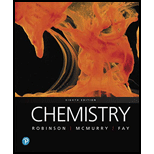
Concept explainers
(a)
Interpretation:
The oxidation state of oxygen in each oxide and the oxidation state of the other element should be determined.
Concept introduction:
Oxygen has six valence electrons in its valence shell, therefore, oxygen can achieve an octet by accepting two electrons from an active metal or by sharing two additional electrons through covalent bonding.
When oxygen reacts with active metals, it gives ionic oxides. With nonmetals, oxygen forms covalent oxides.
All the oxygen in oxides are in
(b)
Interpretation:
Each oxide should be identified as molecular or a solid with an infinity extended three-dimensional structure
Concept introduction:
Oxygen has six valence electrons in its valence shell, therefore, oxygen can achieve an octet by accepting two electrons from an active metal or by sharing two additional electrons through covalent bonding.
When oxygen reacts with active metals, it gives ionic oxides. With nonmetals, oxygen forms covalent oxides.
(c)
Interpretation:
The oxides which are likely to be a gas or a liquid and which are likely to be a high-melting solid should be determined.
Concept introduction:
Most of ionic oxides form crystal lattice structures. Lattice energies are very high, so, the bonds between atoms are difficult to break. So, ionic oxides have higher melting points. Most first row and second row nonmetal oxides have lower melting points, so, most of them exists as gas or liquid at room temperature.
(d)
Interpretation:
The identity of the other element in (2) and (3) should be determined.
Concept introduction:
Oxygen has six valence electrons in its valence shell, therefore, oxygen can achieve an octet by accepting two electrons from an active metal or by sharing two additional electrons through covalent bonding.
When oxygen reacts with active metals, it gives ionic oxides. With nonmetals, oxygen forms covalent oxides.
Want to see the full answer?
Check out a sample textbook solution
Chapter 22 Solutions
EBK CHEMISTRY
- Sodium hypochlorite is produced by the electrolysis of cold sodium chloride solution. How long must a cell operate to produce 1.500103 L of 5.00% NaClO by mass if the cell current is 2.00103 A? Assume that the density of the solution is 1.00 g/cm3.arrow_forwardWhich is the stronger acid, H2SO4 or H2SeO4? Why? You may wish to review the Chapter on acid-base equilibria.arrow_forwardGive examples of two basic oxides. Write equations illustrating the formation of each oxide from its component elements. Write another chemical equation that illustrates the basic character of each oxide.arrow_forward
- Write balanced chemical equations for the following reactions:(a) metallic aluminum burned in air(b) elemental aluminum heated in an atmosphere of chlorine(c) aluminum heated in hydrogen bromide gas(d) aluminum hydroxide added to a solution of nitric acidarrow_forwardPlease Write the chemical equations for the following processes in the image below.arrow_forwardAn element forms an oxide, E2O3, and a fluoride, EF3.(a) Of which two groups might E be a member?(b) How does the group to which E belongs affect the properties of the oxide and the fluoride?arrow_forward
- An element forms an oxide, E₂O₃, and a fluoride, EF₃.(a) Of which two groups might E be a member?(b) How does the group to which E belongs affect the propertiesof the oxide and the fluoride?arrow_forwardWhich of the following statements are true?(a) Si can form an ion with six fluorine atoms, SiF62-,whereas carbon cannot.(b) Si can form three stable compounds containing two Siatoms each, Si2H2, Si2H4, and Si2H6.(c) In HNO3 and H3PO4 the central atoms, N and P, havedifferent oxidation states.(d) S is more electronegative than Se.arrow_forwardThe alkali metals play virtually the same general chemical role in all their reactions. (a) What is this role? (b) How is it based on atomic properties? (c) Using sodium, write two bal-anced equations that illustrate this role.arrow_forward
- Alkaline earth metals are involved in two key diagonal rela-tionships in the periodic table. (a) Give the two pairs of elementsin these diagonal relationships. (b) For each pair, cite two simi-larities that demonstrate the relationship. (c) Why are the mem-bers of each pair so similar in behavior?arrow_forwardConsider the following three statements about the reactivityof an alkali metal M with oxygen gas:(i) Based on their positions in the periodic table, the expectedproduct is the ionic oxide M2O.(ii) Some of the alkali metals produce metal peroxides or metalsuperoxides when they react with oxygen.(iii) When dissolved in water, an alkali metal oxide produces abasic solution.Which of the statements (i), (ii), and (iii) is or are true?(a) Only one of the statements is true.(b) Statements (i) and (ii) are true.(c) Statements (i) and (iii) are true.(d) Statements (ii) and (iii) are true.(e) All three statements are true.arrow_forward(i) Interhalogen compounds are more reactive than halogens exceptF2. Why?(ii) Give one important use of ClF3.arrow_forward
 Chemistry & Chemical ReactivityChemistryISBN:9781337399074Author:John C. Kotz, Paul M. Treichel, John Townsend, David TreichelPublisher:Cengage Learning
Chemistry & Chemical ReactivityChemistryISBN:9781337399074Author:John C. Kotz, Paul M. Treichel, John Townsend, David TreichelPublisher:Cengage Learning Chemistry & Chemical ReactivityChemistryISBN:9781133949640Author:John C. Kotz, Paul M. Treichel, John Townsend, David TreichelPublisher:Cengage Learning
Chemistry & Chemical ReactivityChemistryISBN:9781133949640Author:John C. Kotz, Paul M. Treichel, John Townsend, David TreichelPublisher:Cengage Learning Chemistry: Principles and ReactionsChemistryISBN:9781305079373Author:William L. Masterton, Cecile N. HurleyPublisher:Cengage Learning
Chemistry: Principles and ReactionsChemistryISBN:9781305079373Author:William L. Masterton, Cecile N. HurleyPublisher:Cengage Learning Chemistry: An Atoms First ApproachChemistryISBN:9781305079243Author:Steven S. Zumdahl, Susan A. ZumdahlPublisher:Cengage Learning
Chemistry: An Atoms First ApproachChemistryISBN:9781305079243Author:Steven S. Zumdahl, Susan A. ZumdahlPublisher:Cengage Learning Chemistry: Principles and PracticeChemistryISBN:9780534420123Author:Daniel L. Reger, Scott R. Goode, David W. Ball, Edward MercerPublisher:Cengage Learning
Chemistry: Principles and PracticeChemistryISBN:9780534420123Author:Daniel L. Reger, Scott R. Goode, David W. Ball, Edward MercerPublisher:Cengage Learning Chemistry by OpenStax (2015-05-04)ChemistryISBN:9781938168390Author:Klaus Theopold, Richard H Langley, Paul Flowers, William R. Robinson, Mark BlaserPublisher:OpenStax
Chemistry by OpenStax (2015-05-04)ChemistryISBN:9781938168390Author:Klaus Theopold, Richard H Langley, Paul Flowers, William R. Robinson, Mark BlaserPublisher:OpenStax





